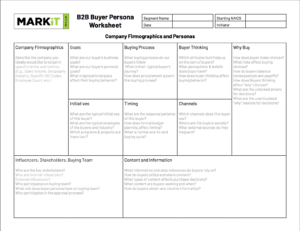What is a Buyer Persona and Why it Matters to You
A buyer persona is a composite sketch of a key segment of your target audience. It is where your next customer most likely to come from. This persona should tell you who at what companies are your ultimate buyers. These personas may differ from job title to job title depending on the different roles each plays in the purchasing process. Each persona has slightly different desires, needs, and wants. Your messaging should be tailored to each persona and address their interests in your product and services. For example, a company may be involved in updating their packaging equipment. There will be several different roles in your prospects buying process. The engineer is looking for flexibility and functionality. The brand manager is interested in new features that distinguish their product on the shelf. The procurement and purchasing department will be interested in value. And, the CEO is asking how much. Each of these roles may require different messaging. Your personas are the defining factor for how you sell and what you present in your digital marketing.
Firmographics vs. Demographics
Firmographics are the attributes B2B companies use to segment their target market in order to discover their ideal consumers.
To better understand firmographics and the role they play in market segmentation, think of B2B companies using firmographics in the same way that B2C companies use demographics. Both are used to segment target markets to reach an ideal audience. Firmographics and demographics are different in the fact that demographics are used to segment consumers and firmographics are used to target businesses.
B2B Customer Segmentation
B2B marketers segment their target market, or other companies and businesses that would be interested in their products or services, based on specific desirable characteristics.
There are countless different criteria for segmenting your target market using firmographics. Here are a few of the more common segmentation categories:
- Industry: What products or services do your target market provide? How does what you are offering help enhance their business?
- Annual Revenue: Are they a Fortune 500 company or do they operate on a smaller scale? Has their revenue increased or decreased over recent years?
- Company Size: Is the company or business you are trying to target a major company or do they work on a smaller scale? Is the company or business a startup or an established leader of their industry? How many employees do they currently have? Are they growing or downsizing?
- Geography/Location: Where is this company located? Are they located in a major city or a small town? Do they have multiple locations around the world or do they operate out of one location?
- Stage in the Sales Cycle: Is the company or business you are trying to target in a position to make a purchase? Or are they merely looking for more information to possibly make a purchase at a later date? The kind of information you present to a company should represent where they are in the buyer’s cycle. One way to refine this is through lead nurturing, or leading your customers through the buyer’s cycle by building relationships and understanding what they want and need.
There are many other ways to segment your target market using firmographics, so it is important to thoroughly analyze your goals and research what kinds of companies or businesses would be interested in your product.
Understanding What You Have to Offer
Before using firmographics to segment your target market for a B2B marketing campaign, make sure you have a complete understanding of what your company has to offer. After all, you are trying to show a potential business customer that your products and services will enhance their ability to do their jobs and achieve results. If you don’t understand what you have to offer, then there’s no way your customers will either.
Keeping firmographic segmentation in mind throughout the B2B marketing process will help to ensure that you are segmenting your market in the most beneficial way and help lead you to the perfect business match.
Once you have performed firmographic segmentation, you’ll be able to identify gaps in your previous marketing strategy. You’ll be able to identify the new, untouched prospects that fall in between these gaps, and you can then target them with future content. (More about firmographics)
Why Firmographics Matter
It’s easy to dismiss B2B firmographics as “just the contact information,” but it’s so much more. You can feed your firmographic data into an AI system to better predict which customers are likely to buy. You can see which companies are growing and which ones are shrinking, which ones have more revenue and which ones are losing market share.
Firmographics can help improve your sales and marketing efforts through:
- Increased sales velocity, which lets you narrow your list of targeted accounts to only those that are a good fit. This helps you reduce the volume of wasted calls and misspent effort trying to connect with prospects who can’t actually use your product or service.
- Improved marketing ROI, which lets you personalize and hyper-target your prospects, zeroing in only on those in a specific region, industry, or revenue size.
- Sophisticated risk assessment. You can complete a more in-depth risk and benefit assessment of each lead, such as a machining company looking for new clients. They can choose to work with companies of a certain size or avoid companies that work in a particular industry, focusing only on those clients that fit their overall company strategy.
Click Here to View & Download our Buyers Persona Worksheet



Recent Comments